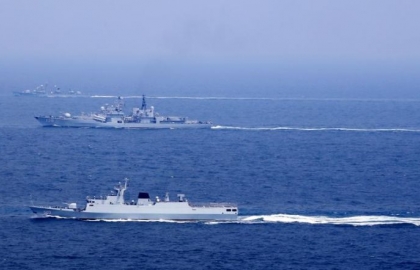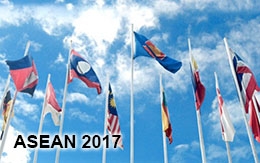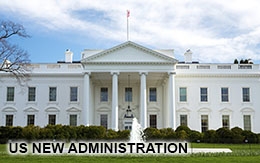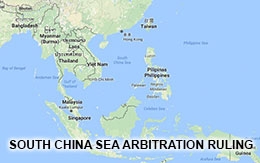The South and East China Sea Disputes and Their Influence on a Revised World Order
Maritime disputes in China’s neighbourhood are important because they confront the key strategic interests of China and the United States as well as their paerceptions of how to define proper conduct and justify sovereignty claims in accordance with international law.

In April 2012, following skirmishes between the Philippine Navy and eight Chinese fishing vessels in the vicinity of Scarborough Shoal, two Chinese maritime surveillance vessels blocked the entrance to the shoal, thereby preventing the arrest of the fishermen. The standoff lasted for two months, after which the Philippines withdrew from the shoal, leaving it under Chinese control. China has turned down participation in the Philippine request for arbitral proceedings with regard to Manila’s bilateral dispute with the PRC. Nevertheless, the Philippines filed the case and it is expected that the arbitral tribunal, which has its seat in The Hague and for which the International Bureau at the Permanent Court of Arbitration serves as the Registry, rules on the case in 2016.
In September 2012, the Japanese government bought three of the Diaoyu/Senkaku Islands in the East China Sea. Both China and Japan claim sovereignty over the islands. Tokyo bought the islands from a private Japanese citizen claiming to be their owner. In the months leading up to the acquisition Japan had tried to persuade China that their intention was to preserve stability in the area and avoid that unpredictable actions taken by private citizens contribute to conflict escalation.
The Obama administration of the United States (US) warned Japanese Prime Minister Abe that the acquisition might cause a crisis in Sino-Japanese relations, encouraging Tokyo to change its mind. Japan chose to go ahead and buy the islands. Initially, China reacted by criticizing the decision of the Japanese government and harassing Japanese businessmen in China. Subsequently, the Chinese coast guard stepped up patrolling in the seas surrounding the Diaoyu/Senkaku islands. Both countries consider the islands to be their territory. From September 2012 until 2015, the frequency of confirmed Chinese patrols is between 5 and 28 per month, with a stable frequency from 2014 to lower navigation safety risks. China has established a semi-permanent maritime presence in the waters in the vicinity of the Diaoyu/Senkaku islands. More than 300 Japanese flights over the islands with fighter aircraft in 2013 signify that Tokyo closely surveys the Chinese presence. Moreover, Japan uses the media to draw attention to China’s activities in the East China Sea.
In the US and among US allies in Europe and Asia, China has been met with general condemnation as regards its behaviour in the South and East China Sea. China is considered to be performing regular illegal breaches of the freedom of the high seas and airspace in what is defined as international waters by the majority. Moreover, China is accused of breaching the sovereign rights of neighbouring countries in the South and East China Seas. By contrast, in China’s view the diplomatic and physical situations of conflict with neighbouring states reflect the growing assertiveness of the US alliance system. According to China, this assertiveness involves illegal encroachments on Beijing’s alleged sovereign rights and on the right of regional states to exercise effective control and manage security issues in their neighbourhood without third party interference. China’s perception of threats towards its basic security interests engenders China to focus on redressing the balance of power in its favour and on promoting its interpretation of legitimate conduct in its maritime neighbourhood.
This chapter argues that the conflicts in China’s maritime neighbourhood derive their significance from the fact that they confront central Chinese and US strategic interests and perceptions of rights and responsibilities with regard to sovereignty issues. As a consequence, developments in the South and East China Seas are essential to the definition of the rules of conduct of the future regional and global order. As China gradually builds up the economic and military capabilities that are necessary to implement Beijing’s definition of its sovereign rights and security needs in its maritime neighbourhood, tension levels between China and the US and its allies and partners increase. China’s neighbours do not accept voluntarily to have their freedom of action and rights reduced due to an increased Chinese presence.
Interests, Objectives and Strategy in the South and East China Sea
China has numerous interests in the South and East China Seas. Resource considerations are at times pointed to as central to China’s behaviour in its maritime neighbourhood. Although resources play a central role in state interaction and have been a source of contention and cooperation between the claimants, I argue that these are not significant enough to explain that the South and East China Sea disputes have become key issues between China, its East Asian neighbours and the US.
Hydrocarbon, mineral and fish resources all play a role in the area. The oil and gas reserves are unknown and for the most part expensive to exploit. The fish resources are highly important due to the swiftly growing demand for animal protein as the Chinese middle class continues to grow. In addition, the sea lanes of the South China Sea are central to commercial and military traffic. One of the most important sea lanes in the world is the Malacca Strait, linking the Indian and Pacific Oceans and carrying about a quarter of the world’s traded goods, including export of Chinese manufactured products and Middle Eastern oil exports to China.
China’s strategic interests in the South and East China Seas are significant since these areas allow China maritime access to the Indian Ocean and the Pacific. China feels threatened by the US alliance system which ironically is at its strongest in China’s maritime near abroad. China’s response is to gradually increase its presence in the area to expand its sphere of influence and push back the maritime based US alliance system.
China’s naval base on Hainan Island, which is China’s southernmost province, includes an underwater submarine base and constitutes an administrative and strategic centre for China’s interests in the South China Sea. In the South China Sea, Woody Island, which is the largest island in the Paracels, is the main Chinese forward outpost and holds an upgraded airstrip and a division-level garrison. Qingdao in the eastern province Shandong hosts China’s North Sea Fleet and China’s first aircraft carrier Liaoning. The carrier was moved here in 2013. The carrier is under the direct control of China’s Central Military Commission, which is chaired by President Xi Jinping.
Some of China’s actions in the South China Sea can be seen as tests of the US alliance system. For example, when China’s first aircraft carrier Liaoning made its first training deployment to the South China Sea in 2013, the US dispatched the guided-missile cruiser USS Cowpens to monitor the exercise. This caused the Chinese People’s Liberation Army Navy (PLAN) to send one of the surface ships in the battle group to block its path, thereby risking a collision with the US cruiser. The Chinese action sent the signal that it considers the waters to be under Chinese sovereignty, whereas the US considers it to be international waters. Consequently, the incident resulted in mutual US-Chinese public accusations of irresponsible behaviour. Another example is China’s announcement of an Air Defence Identification Zone (ADIZ) in the East China Sea in November 2013. China’s ADIZ overlaps with the existing Japanese ADIZ.
Both zones encompass the Diaoyu/Senkaku Islands. The Air Defence Identification Zone heraldedChina’s decision to duplicate its maritime strategy in the air in the sense that China started patrolling the airspace over the Diaoyu/Senkaku Islands. Immediately after China’s announcement the US overflew the Diaoyu/Senkakus with two B-52 bombers without asking Beijing for permission. The US overflight was carried out despite Beijing’s prior announcement that China would exercise effective control within the ADIZ. China chose not to respond to the US action. Thereby, further destabilization was avoided. China, the US and Japan has subsequently continued the game for rights in the airspace with repeated unannounced overflights, causing continuous concern about a possible collision.
The Vision of the Chinese Motherland
China’s long-term aspiration in the South and East China Sea is to restore what it considers to be historic Chinese motherland. The submission of the Chinese empire to Western powers and Japan in the late nineteenth century resulted in Japan’s attempt to establish a so-called Japanese co-prosperity sphere which resulted in Japanese occupation of territory across Southeast and East Asia, including key islands in the South and East China Sea. In some cases, demonstration of effective control was merely a question of Japanese soldiers marking islands with flags, thereby applying Western rules of sovereignty. In China’s view, another understanding of sovereignty applied in Asia which did not entail effective occupation but rather symbolic recognition of ownership of territory and maritime space by other countries’ heads of state combined with Chinese people’s recurring use of the space.
Hence, China does not recognize Japan’s Western-style sovereignty claims, which entailed placing markers on islands that were declared unoccupied territory to identify them as Japanese and occupation of key strategic islands in the South China Sea. Moreover, Beijing argues that the 1943 Cairo Declaration between the US, the United Kingdom (UK) and China which ejected Japan from all the territories it had conquered, including the South China Sea island groups and the Diaoyu/Senkakus, implied that these territories should be returned to China. China’s long-term aspiration is to recover territories that were not returned after the Second World War.
...
Liselotte Odgaard is an Associate Professor at the Institute for Strategy, Royal Danish Defence College, Copenhagen, Denmark.
The paper was presented at the High-level Workshop: "Maritime Issues and United Nations Convention on the Laws of the Sea: Sharing European and Asia Approaches to Territorial Disputes", 4-5 June 2015, Halong Bay, Vietnam. This workshop is co-organized by Diplomatic Academy of Vietnam (DAV) and EU Delegation in Hanoi through EU-Vietnam Strategic Dialogue Facility.
Click here for full text.










